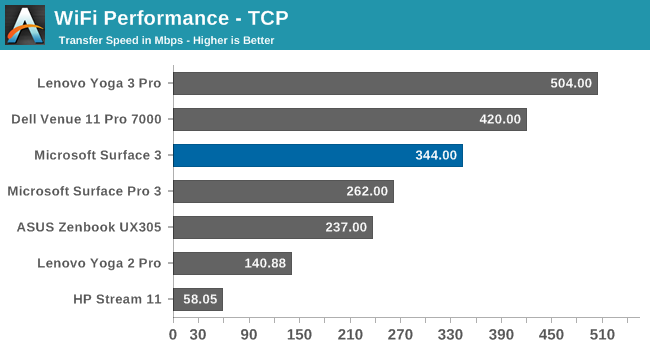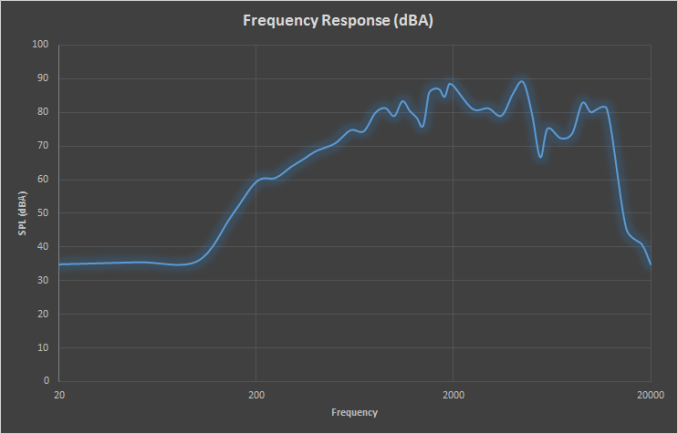The Surface 3 Review
by Brett Howse on May 4, 2015 9:00 AM ESTWi-Fi Performance
For networking, the Surface 3 features the same Marvell AVASTAR 802.11ac network adapter as its big brother. I have seen a lot of the firmware updates for Surface Pro 3 over the last year being network related, so hopefully they have all of the bugs out of it by now. During my time with the Surface 3, I did not have any issues with it. It is a standard 2x2:2 setup, and the top of the Surface 3 has a plastic section to act as a RF window.

The average speed during our TCP test was just about 350 Mbps, which is not too bad but well off of the Broadcom devices, which can see over 500 Mbps.
Speakers
The Surface 3 features to forward facing speakers hidden in the display bezel. It makes for a nice look, and having the speakers facing you helps a lot with stereo and should help with the overall sound quality too.
The Surface 3 is not especially loud, and the frequency response is about what you would expect for a small device with no room for proper speakers. There is almost no sound below 150 Hz, and around 15 kHz the sound drops away. Maximum volume I observed while playing music was 76 dB(A).
Camera
This tablet has two cameras, with the rear camera being an auto-focus 8 MP unit, and the front facing camera is actually a decent camera as well, with 2304 x 1536 resolution shots. The one quirk with the front facing camera though is that it really works best when the kickstand is in the first position, and because this is not a laptop with an adjustable hinge, you will always be limited to where it points.
The rear camera though is surprisingly good, even in low light. I am still not a fan of using a tablet to take pictures, but if you have to, this one will please you.
It will work in a pinch, but I will stick to my smartphone when I can.












265 Comments
View All Comments
asfletch - Wednesday, May 6, 2015 - link
Reading and re-reading this review leads me to one conclusion - the Dell Venue Pro 11 7140 is a superb piece of engineering (if not design) and would be my ideal tablet, if not for the accursed 16:9 screen. It's also a deal-breaker on the T300 Chi. I guess I'm hanging out for a Core M SP4 (although I would prefer a slightly smaller tablet). Oh well.serendip - Wednesday, May 6, 2015 - link
Maybe I'm crazy... I use a Lenovo Miix 2 8" tablet with the older Bay Trail Z3740 as my main computing device and it's been good enough for more than a year. Office documents open fine, I can even run Linux VMs (mainly console stuff), the battery lasts 9 hours and with a portable keyboard, I have my office in under 800 grams.I paid a lot less than the Surface 3's price though. At $499, the Surface 3 is overpriced and the dock pricing is outrageous.
beggerking@yahoo.com - Wednesday, May 6, 2015 - link
mix 2 8" is great, but this is a 10-11".$499 is a bit high (should be sold for $299-399) but the build-in kickstand along..believe it or not, is so important that its actually worth the extra $100...
Yes i have Dell Venue 8, Miix 2, and insignia 8" and they all run great with 1-2 gb of ram and battery lasts forever, all cost < $250
accessories are always overpriced for any model.
Luc K - Thursday, May 7, 2015 - link
The Miix 2 10" actually also started at $499 (you see now discounts since it's > 1 year old device with last gen slower Atom CPU).domski - Wednesday, May 6, 2015 - link
How is pixel density related to backlight power consumption? The article implies the two are connected, but I don't see how.For an LCD, backlight power is usually just directly proportional to screen area and brightness. The pixel density may affect power consumption of the GPU and LCD driver hardware, and maybe also the liquid crystal matrix itself.
Is author (Brett Howse) mistaken? If not, can someone enlighten me about the connection between backlight power and pixel density?
Brett Howse - Wednesday, May 6, 2015 - link
I'm going to pull in a quote from another article which sums it up nicely:"The increase in number of pixels (and transistors powering the display—one for each RGB subpixel) comes with a corresponding increase in the percentage of light being blocked by the transistors and filaments. Thus, the percentage transparent area for each pixel is lower, necessitating a significantly stronger backlight when pixel density is increased."
http://www.anandtech.com/show/5688/apple-ipad-2012...
Brett Howse - Wednesday, May 6, 2015 - link
Also this is one of the advantages of IGZO TFTs is that the actual TFT (Thin Film Transistor) http://en.wikipedia.org/wiki/Thin-film_transistor is less opaque, so more light gets through as compared to Amorphous Silicon TFTs which are the standard (and cheaper) way they are done.buevaping - Wednesday, May 6, 2015 - link
I looked at the Surface 3 at the store today. The sales guy and I were shaking are heads about entry level specs with 2 gigs of ram. "Why doesn't the Windows button not work?" "Oh It probably needs to be shut down and restarted." I don't need a touch device that badly.Luc K - Thursday, May 7, 2015 - link
You can disable the Windows button in the surface app. Not sure why you say 2 GB is major issue. Did you see any issues? Lots of tablets with Atom have 2 GB running 8.1.domboy - Thursday, May 7, 2015 - link
Thank you for the wonderful review. While it makes sense to compare the Surface 3 to current product offerings, especially the Pro 3, I am slightly disappointed that there is not much in the way of comparison to the products it replaces - the Surface RT/2. I realize most of the benchmarks won't run on Windows RT, but the web browser tests and the store version of 3DMark could have been run, as well as some sort of battery life comparison. I'm going to assume that perhaps this is because you don't have older Surface models on hand, but I know this data has been gathered in the past and I think it might have been helpful to include for Surface RT/2 owners that may be considering upgrading.I do think it's a compelling product just to get proper pen support and x86 compatibility, though the RT jailbreak went a long way for me to be able to live with the original Surface RT which is what this would replace in my case. I do know the Asus T100 is faster than the original Surface RT, but I don't know how it compares to the Surface 2 speed-wise.